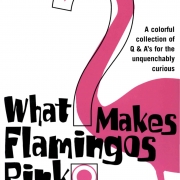Blog Content By and For the Unquenchably Curious
This week’s Say It For You blog posts are based on the book What Makes Flamingos Pink, by Bill McLain, “a colorful collection of Q & A’s for the unquenchably curious”…
One thing it’s always a good idea to include, I tell content marketers, is interesting information on topics related to their business or professional practice. If you can provide information most readers wouldn’t be likely to know, we explain at Say It For You, all the better. So long as there’s a real “back story” demonstrating valuable lessons learned and why that information should matter to the web visitor, tidbits can prove to be enormously useful tools….
The color of most birds is a matter of genetics, McClain explains in the book. Bluebirds are blue by nature, cardinals red for the same reason – their inherited genes. Famingos are different – they are pink because their diet is heavy in natural pigments called carotenoids. Wisely, the author is quick to show readers the relevance of that information – “When we eat carrots or beets, we are also eating carotenoids,” he explains. ” But no matter how many beets and carrots we eat, the only way we can turn pink is to blush or get a sunburn,” he adds.
One big goal of the writing we do for our business owner and professional practitioner clients is positioning them as experts in the eyes of both their existing clients and their web visitors. While good blog post content can and should be entertaining, it’s important to remember that most online searchers are not pursuing a recreational activity, but instead are on a fact-finding mission. You can hook them, we teach at Say It For You, with humorous and fascinating trivia tidbits, but the material you serve up needs to be meaningful to that audience and – actionable.
The factoid about flamingos’ pink coloring is an example of how trivia can be used in content marketing to accomplish a variety of initiatives: defining basic industry terminology, sparking curiosity about the subject, putting modern-day practices and beliefs into perspective, and explaining why the business owner or practitioner chooses to operate in a certain way.
Always remember, though – they may be “unquenchably curious”, but online visitors are rarely unquenchably patient. Structure the content so as to address the two questions “So what?” (why it might matter) and “Now what?” directing them to the next step.






Follow us online!